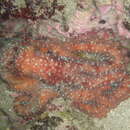Comprehensive Description
provided by Smithsonian Contributions to Zoology
Octopus luteus (Sasaki, 1929)
DIAGNOSIS.—Animal large (110–125 mm ML). Mantle ovoid (MWI 46–56); head narrow (HWI 32–35). Funnel moderate in size, funnel organ W-shaped, medial limbs larger than lateral limbs. Arms short to moderate in length (ALI 61–75), strongly unequal in length, arm formula I > II > III > IV. Right arm III of males hectocotylized (HALI 195), with 88 suckers, shorter than fellow (FAI 61); ligula small (LLI 4). Web shallow (WDI ∼18). Gill lamellae 12. Penis elongate, penis diverticulum recurved. Spermatophores moderate in size (SpLI 68.2), slender (SpWI 1.4), with about 25–30 coils of sperm mass. Surface of mantle covered with variously sized, pimple-like papillae, those above eyes slightly larger; ventral surface smooth. Color in preservation reddish brown with darker blotches dorsally, paler ventrally.
ORIGINAL DESCRIPTION.—Sasaki, 1929:45, fig. 160, pi. 27: figs. 6–9, pi. 29: figs. 4, 5, as Polypus luteus.
TYPE LOCALITY.—Western North Pacific Ocean, Formosa Strait, Pescadores Islands (= Taiwan, P'eng-hu Lieh-tao).
TYPES.—Syntypes: ACS, 1 male, 110 mm ML, 1 female, 125 mm ML.
DISTRIBUTION.—Known only from the type locality.
- bibliographic citation
- Voss, N. A. and Sweeney, M. J. 1998. "Systematics and Biogeography of cephalopods. Volume II." Smithsonian Contributions to Zoology. 277-599. https://doi.org/10.5479/si.00810282.586.277

